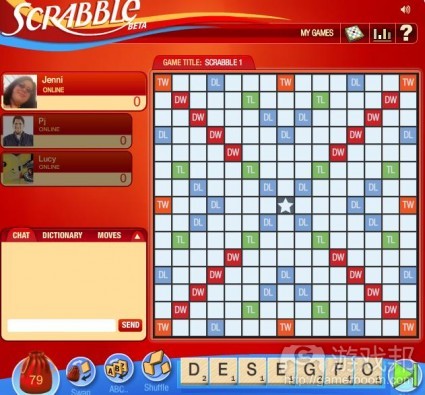探讨时间范畴上的同步与异步玩法及其关联性
作者:Tadhg Kelly
异步游戏玩法是个近期较为流行的术语,它描述的是各种将玩家联系起来但不要求他们同时在线的网游所采用的做法。许多资深评论员都谈论过此类玩法成为未来游戏趋势的可能性。
但是,Ian Bogost、Raph Koster和我在Gamasutra上开展讨论时发现,这些术语的含义有些模糊不清。Raph认为异步游戏已经存在了数百年之久,比如用信件来玩的象棋。但是我觉得用信件来玩的象棋属于同步游戏。也就是说,我们两人对游戏同步性的理解有所不同。
许多人认为,同步指的是玩家在现实时间中同时进行游戏。但是我觉得,同步游戏需要的只是玩家在游戏时间中同时存在。这篇文章将详细阐述这个想法,探究现实时间和游戏时间的差异。
游戏时间和现实时间
许多游戏要求玩家在现实时间中的同步。体育、动作游戏、主机射击游戏、竞速游戏以及更多游戏提供的都是实时体验,一个或更多玩家在游戏中做出动作或反应。但是,就像重量和质量的关系一样,游戏时间和现实时间也有所不同。只有在某些特别的情况下才能显示出二者的差异。
诸如《传送门2》之类的单人游戏或许仰赖的是现实时间,但玩家有可能必须离开电脑去煮饭。如果出现这种情况,那么游戏就会被暂停或者保存,以便随后回到游戏中继续。
在信件象棋游戏中,某次移动可能在数天之内都无法得到回应。桌面角色扮演游戏可能在现实时间中经历多次的开始和暂停,跨越很长的时间阶段。
游戏时间通常存在于游戏世界中,其推移并不像现实时间那样每秒都在流逝。然而,现实时间就存在于我们周围,总是以相同的速度向前推移。
这便是两者间的重要差别。
同步
同步是所有游戏的特性:
如果某个循环中的部分胜利需要超过1名玩家的行动方能实现,那么这就是个同步循环。否则,就属于异步。
同步被广泛运用于各种游戏模式中。单人游戏和多人游戏是最为普遍的模式,也有些混合型的游戏。比如,《CityVille》大部分属于异步游戏,但是要求你雇佣好友在某个建筑物中任职却是个例外。雇佣要求好友做出动作才能帮助你完成循环以获得胜利,所以这属于同步。
这也是为何我以循环来定义同步,而不是将术语架构在整个游戏之上。循环是游戏玩法中的基本成分,玩家做出动作之后游戏以某种方式做出响应,决定玩家胜利、失败或进入另一个循环。在异步循环中,响应来源于游戏本身,但是同步循环的完成需要仰赖其他玩家。
循环的长短各不相同。在《光晕》的团队竞技模式中,循环是跟随现实时间进行的,但是在信件象棋中,只有当移动完成一轮后游戏时间才有所前进。所以,单个循环可能要花上数天时间才能完成。对其他玩家参与的需求也有差别。这就是为何与同步相关的是游戏时间而不是现实时间的原因所在。
时间范畴
同步玩法更非正式的定义是“同时玩游戏”。我所定义的对其他玩家的依赖并没有包含在这个定义中。
对我来说,这个定义很不清楚。在游戏设计时考虑到玩家间的联系与上述简单的同步定义大不相同。《YoVille》和《光晕》的死亡模式都是玩家群体同时在玩游戏,但它们是完全不同的。
在Gamasutra的讨论中,我认为同步或异步的非正式定义并不能恰当描述同步。我将其用时间范畴来概述。时间范畴的定义是:
如果游戏的玩法包含两个或更多玩家同时存在,那么就是同时间范畴。否则,就是不同时间范畴。
所以,《反恐精英》或《德州扑克》属于同时间范畴游戏,但是《质量效应》和《Chu Chu Rocket》属于不同时间范畴游戏。
时间范畴关注的是玩家是否同时出现在同样的地方,至于为何他们要这么做就显得无关紧要。
两者的对立统一
同步和时间范畴之间相互作用的方式令我感到十分有趣。
比如,当你在《Farm Town》中访问好友时,他刚好也在线。你帮他收割作物并且你们之间正在聊天。这属于同时间范畴,但并不属于同步。之所以属于同时间范畴,因为你们两个人同时出现在相同的地方。但是之所以属于异步,是因为他本不需要你帮他收获作物。也就是说,你的帮助并非他获得胜利的必要条件。
换个例子,你的好友在《CityVille》向你发出了个赠礼请求。他需要大理石以帮他完成社区建筑的建设,所以希望你能够送他一些。这不属于同时间范畴,因为你无须同时在线也能够发送或收到信息。但是属于同步,因为他需要你的帮助才能够盖起建筑。
同步和时间范畴相互交叉,产生同时间范畴同步、同时间范畴异步、不同时间范畴同步和不同时间范畴异步四种类型。用更容易理解的方法,就是多人游戏、平行游戏、回合游戏和单人游戏四类,虽然并不是很精确。
同步和时间范畴的结合在各种情况下的效果各不相同,而且理解其中的缘由很重要。每种结合方式都在不同程度上测试玩家的忍耐力,所有同步和时间范畴成为游戏中的主要参数。
忍耐力
忍耐力是指玩家会有多大的耐性留在游戏中。
游戏中的所有内容,从教授玩家游戏规则的方式到要求玩家付费的方式,都在测试着玩家的忍耐力。常见的规则是,游戏对玩家的吸引力越小,他们的忍耐力就越弱。
忍耐力是所有游戏无法避开的因素,但是你应该尽量将其减少。同步和时间范畴以许多方式测试着忍耐力。你应该记住,玩家并非都像想象中那样理想。
Jane McGonigal在《破碎的现实》(Reality is Broken)一书中引用了有着数百万玩家的异步游戏《Lexulous》作为例证。这款游戏利用了《Scrabble》(游戏邦注:原名为《Scrabulous》)的基本规则,成为Facebook上的热门游戏。但是,与Jane撰写书籍时引用的那时相比,这款游戏已经失去了大部分的用户。
原因在与《Lexulous》是同步游戏,而并非异步。玩家有时会忘记或不想在自己的回合中做出行动,这使得许多场游戏无故夭折。对于其他与上述玩家一起玩的人来说,对方不做出行动也使他们觉得游戏乏味,因而也使离开游戏的可能性上升。游戏达到了他们忍耐力的临界点。
这便是不同时间范畴同步玩法可能产生的问题,但也正是这种玩法吸引了那些真正愿意在《Scrabble》中投入时间的人。尽管这种游戏的MAU相对较低,但是他们的用户参与度比例(游戏邦注:35%-50%)都比多数Facebook要高。如果玩家真正喜欢《Scrabble》,他们会记得在自己的回合中做出行动。
如何解决同步和时间范畴的另一个范例是《Left 4 Dead》的做法。游戏讲究的是协作性玩法,如果不在游戏中进行协作就会死亡。
但是,这种设计的主要问题在于玩家离开或加入游戏的方法。如果游戏过分依赖协作性玩法,那么当玩家中途掉线怎么办呢?
《Left 4 Dead》解决这个问题的办法是,当玩家掉线时加入AI角色,而且这个AI角色的技术足够让其余玩家获得完全合乎逻辑的体验。如果其他玩家想要加入游戏,那么AI角色随时都会退出,这样忍耐力问题就被降到最小。
总得来说,游戏的协作性越强,玩家的数量就会越少。如果游戏完全依靠玩家的协作来运转,那么就很可能拥有少量对游戏极有激情的用户。
《魔兽世界》多数部分属于异步游戏,只有少部分玩家会加入公会参加活动。到目前为止,《德州扑克》是最为流行的在线纸牌游戏,部分原因是因为游戏的进入退出都很容易。更为严格的纸牌游戏的用户数就会更少。
最后,减少用户的忍耐是许多免费增值模式游戏的基础。在《CityVille》中,你可以付费购买大理石,而不用等待好友送给你。在《Ikariam》中,你也可以付费让游戏加速。这种模式之所以能够成功,正是因为玩家不想等待,他们愿意支付些许金钱来跳过这些繁琐的工作,回到游戏的趣味成分中。
结论
趣味性有各种各样的形式,每个人都想要得到。有些形式需要玩家比其他人付出更多,有些形式需要处理同步和时间范畴的相关问题。澄清二者间的特性和差异,我们就更容易理解它们之间相互作用的方式,避开设计中可能产生的错误。
所以,更清晰地理解术语能够让我们成为更棒的游戏设计师。(本文为游戏邦/gamerboom.com编译,如需转载请联系:游戏邦)
Opinion: Synchronous or Asynchronous Gameplay
Tadhg Kelly
Asynchronous gameplay is a popular phrase for describing various forms of online games that connect players but don’t require simultaneous play. Many eminent commentators have talked about the possibilities for this kind of gameplay, and how it might be the future for games.
However, in a fascinating debate on Gamasutra initiated by Ian Bogost, Raph Koster and I ran across a confusion of terms. Raph said that asynchronous games have existed for hundreds of years, citing play-by-mail Chess as an example. Except I think play-by-mail Chess is synchronous. When talking about synchrony, we actually meant two entirely different things.
Where many people casually talk about synchrony in relation to whether players are together in real time, I think it means games that require players to be in sync with one another in game time. This article elaborates on that idea and describes how real and game time intermingle.
Game Time or Real Time
Many games are played in real time. Sports, action games, console shooters, racing games and more are all real-time experiences in which one or more players acts and reacts to a world that in motion. However, like weight and mass, game time and real time are not the same thing. They only appear to be so under certain circumstances.
A single player game might be played in real time, such as Portal 2, but then you have to go away and cook dinner for your wife. So the game is paused or saved, to come back later.
A single move in play-by-mail Chess might not receive a response for several days. A tabletop roleplaying campaign may start and stop over a number of discrete sessions of real time spaced out by long periods where the game is not being played.
Game time is always internal to the game world, and it may not tick forward on a second-by-second basis. Whereas real time is all around us all of the time and always ticks at the same rate (relativity not withstanding).
This is an important distinction.
Synchrony
Synchrony is a property of all games:
If the achievement of a win as a part of a loop depends on the actions of more than one player, that loop is synchronous. If not, it is asynchronous.
Synchrony is often used broadly, such as different game modes. Single and multiplayer modes are the most common example, but there are some subtle mixes also. CityVille, for example, is a mostly asynchronous game with the exception of the gating mechanism that requires you to hire friends to work in a building. Gating requires their action to complete the loop for you to win, so that is synchronous.
That’s why I describe synchrony in terms of loops rather than the whole game. A loop is a basic molecule of gameplay in which the player takes an action and the game reacts in some way, determining whether the player experiences a win, a loss, or another loop. In an asynchronous loop the reaction comes from the game itself, but in a synchronous one it is dependent on other players.
Loops also vary in length. In team deathmatch Halo the loops are in real time, but in PBM Chess the game time only ticks forward when a turn is taken. So a single loop might take days to close. And yet the need for involvement of other players is the same. So that’s why synchrony is related to game time rather than real time.
Temporany
The more casual definition of synchronous gameplay means ‘playing at the same time’. The dependency on other players that my definition implies is not present, so it could mean players playing alongside each other within a common space, or competitively, or in parallel.
For me that’s just too hazy. Designing with player dependency in mind is very different to that of simple simultaneous presence. YoVille and deathmatch Quake may both be played by groups of players online at the same time, but they are completely different. It is not enough to say they are both ‘synchronous’.
In the debate on Gamasutra, I suggested that the casual definition of synchronous or asynchronous is actually describing a different property to synchrony. I labelled it temporany. The definition of temporany is:
If the play of the game contains the simultaneous presence of two or more players, it is contemporal. If not, it is atemporal.
So your Counter-Strike session or Texas Hold’Em games are contemporal, but your Mass Effect or Chu Chu Rocket games are atemporal. Wandering around Playstation Home or YoVille is contemporal, but visiting a friend’s restaurant in Restaurant City is atemporal.
Temporany is about whether players are in the same place at the same time or not, irrespective of why they are so.
Where the Twain Shall Meet
The fun part (for me at least) is how synchrony and temporany interact with one another.
For example: You visit your friend in Farm Town, and he is online at the same time. You help him clean up his crops and chat to one another. Is that contemporal? Yes. Is it synchronous? No. It’s contemporal because both of you are in the same space at the same time. However it’s asynchronous because he doesn’t actually need you to help clean up those crops. Your help is not a requirement of his win.
On the other hand: Your friend in CityVille sends you a gift request. He needs Marble to help complete his community building, and asks you to send him some. Is this contemporal? No, it’s atemporal because you do not need to be online at the same time to send or receive the message. Is it synchronous? Yes. He needs your help to win.
Synchrony and temporany form a grid. There is contemporal synchrony, contemporal asynchrony, atemporal synchrony and atemporal asynchrony. More conventionally, although less accurately, you might call them: multi-play, parallel-play, turn-based-play and single-play. Quake, World of Warcraft, WeeWar, Portal 2.
Not all combinations of synchrony and temporany work equally well in all situations, and it’s important to understand why. Each tests the tolerance of players differently, and so synchrony and temporany actually form one of the major constraints on all games.
Tolerance
Tolerance is the degree to which your game tests the patience or goodwill of players before they will stop playing.
Everything from teaching the player the rules of the game, to how it asks for money, tests player tolerance. The general rule is that the less engaged the players are, the lower their tolerance.
Tolerance is an unavoidable factor in all games, but you should always try to reduce it where possible. Synchrony and temporany test tolerance in many ways. Largely this is because of the fallibility of individual players, but it’s up to you to remember that players are not ideal and design for that.
Lexulous is a game cited by Jane McGonigal in Reality is Broken as an example of what she calls an asynchronous game with millions of players. Using the basic rules of Scrabble (and originally named Scrabulous), the game was a major hit on Facebook. However, contrary to when Jane wrote her book, it has lost practically all of its 5m users. As have the official versions of Scrabble that followed it.
The reason is Lexulous is synchronous, not asynchronous. Players either forget or don’t want to take their turn, which leaves many individual games orphaned. It’s not fun for other players relying on the forgetful player either, so they are more likely to drift away too. Their tolerance has been reached.
It’s an example of how atemporal synchronous (i.e. turn-based) play can have major issues – but also of how, for the more engaged players of Scrabble, it’s not a problem. All three games may have low MAU, but they have very high engagement rates (35-50%) compared to most other Facebook games. If you love Scrabble, you’ll remember to take your turn.
Another example of how games overcome issues of synchrony and temporany is drop-in/drop-out play in Left 4 Dead. The game is based around cooperative play and, unlike most cooperative shooters, you really can’t just go it alone if other players let you down. If you do you will die.
However the major problem with this design is how players leave or join the game. If the game is reliant on cooperative play then what happens when a player disconnects mid-session?
Left 4 Dead solves this by always being ready to drop an AI character in if a player drops out, and the AI is good enough to make the experience nearly seamless for the remaining players. The AI character is also ready to drop out again if another player wants to join the game. And so tolerance issues are minimised.
What tends to work least well (in terms of tolerance) is designs where players have to depend on each other. In social games the need for scale is paramount for this reason. Similarly, online team sports (such as Football Superstars) also have significant issues because of tolerance.
Generally speaking, the more co-ordinated a group needs to be, the more likely it is to represent only a fraction of players in the game. And if the game is wholly reliant on a co-ordinated group of players, the more likely it is to have a smaller – but passionate – audience.
World of Warcraft is largely played asynchronously, for example, and only a small subset of players get into the guild side of it because it’s a hassle (as satirised wonderfully by The Guild). Texas Hold ‘Em is by far the most popular card game online in part because it’s easy to step in and out of. More serious card games tend to have much smaller audiences.
Finally, easing tolerance is the basis of many freemium business models. In CityVille you can pay for that Marble instead of waiting for your friends to send it, and in Ikariam you can speed your game up by paying. It works because players don’t want the aggravation that comes with waiting, and a small amount of cash seems an easy price to pay in order to get away from busywork and back to having fun.
Conclusion
Fun comes in many forms, and everybody wants to have some. Some of those forms ask more of players than others, however, and some of them have to account for issues of synchrony and temporany in ways that others do not. By clarifying what those two properties are, we are more easily able to see how they interact – and thus account for likely pitfalls in our designs.
So the point of getting the terminology clear is that it makes us better worldmakers. (Source: Gamasutra)










































 闽公网安备35020302001549号
闽公网安备35020302001549号